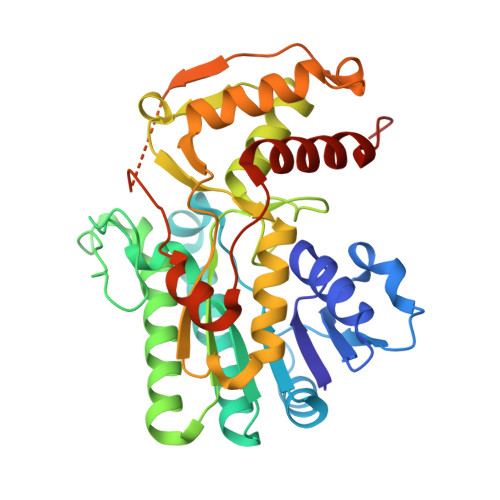Structure and Function of Both Domains of Arna, a Dual Function Decarboxylase and a Formyltransferase, Involved in 4-Amino-4-Deoxy-L- Arabinose Biosynthesis.
Williams, G.J., Breazeale, S.D., Raetz, C.R.H., Naismith, J.H.(2005) J Biol Chem 280: 23000
- PubMed: 15809294
- DOI: https://doi.org/10.1074/jbc.M501534200
- Primary Citation of Related Structures:
2BLL, 2BLN - PubMed Abstract:
Modification of the lipid A moiety of lipopolysaccharide by the addition of the sugar 4-amino-4-deoxy-L-arabinose (L-Ara4N) is a strategy adopted by pathogenic Gram-negative bacteria to evade cationic antimicrobial peptides produced by the innate immune system. L-Ara4N biosynthesis is therefore a potential anti-infective target, because inhibiting its synthesis would render certain pathogens more sensitive to the immune system. The bifunctional enzyme ArnA, which is required for L-Ara4N biosynthesis, catalyzes the NAD(+)-dependent oxidative decarboxylation of UDP-glucuronic acid to generate a UDP-4'-keto-pentose sugar and also catalyzes transfer of a formyl group from N-10-formyltetrahydrofolate to the 4'-amine of UDP-L-Ara4N. We now report the crystal structure of the N-terminal formyltransferase domain in a complex with uridine monophosphate and N-5-formyltetrahydrofolate. Using this structure, we identify the active site of formyltransfer in ArnA, including the key catalytic residues Asn(102), His(104), and Asp(140). Additionally, we have shown that residues Ser(433) and Glu(434) of the decarboxylase domain are required for the oxidative decarboxylation of UDP-GlcUA. An E434Q mutant is inactive, suggesting that chemical rather than steric properties of this residue are crucial in the decarboxylation reaction. Our data suggest that the decarboxylase domain catalyzes both hydride abstraction (oxidation) from the C-4' position and the subsequent decarboxylation.
Organizational Affiliation:
Centre for Biomolecular Science, The University of St. Andrews, UK.














